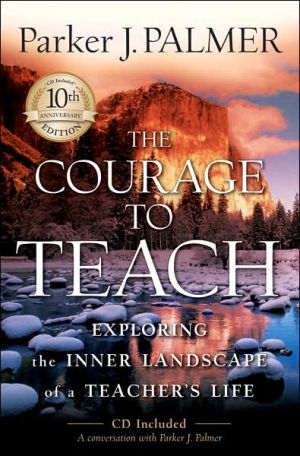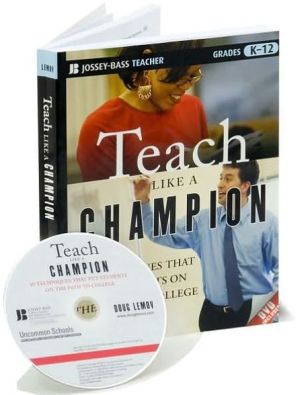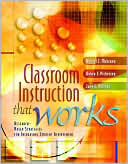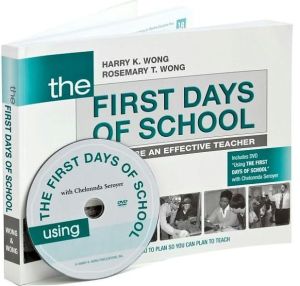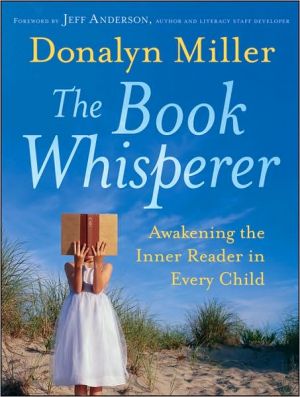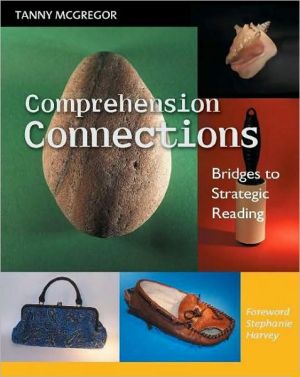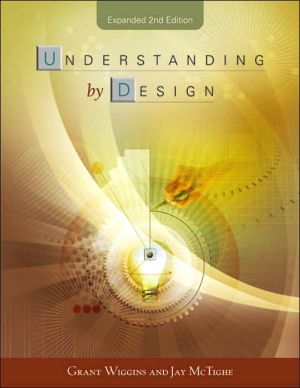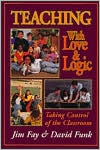The Courage to Teach: Exploring the Inner Landscape of a Teacher's Life
Celebrating 10 Years of The Courage to Teach\ I am a teacher at heart, and there are moments in the classroom when I can hardly hold the joy. . . . But at other moments, the classroom is so lifeless or painful or confused—and I am so powerless to do anything about it—that my claim to be a teacher seems a transparent sham. . . . If you are a teacher who never has bad days, or who has them but does not care, this book is not for you. This book is for teachers who have good days and bad, and...
Search in google:
A look at the inner life of the dedicated teacher: what it means to teach, what it takes to truly connect with students, and the importance of self-realization. Publishers Weekly Spiritual nurturing has been at the heart of both of Palmer's previous books, The Active Life and To Know as We Are Known. A teacher, speaker and writer who contends that teaching is an integral part of all his work, Palmer now explores the spirituality of teaching. He contends that the task of teaching is filled with joy and fear, success and failure, but, he says, "good teaching cannot be reduced to technique; good teaching comes from the identity and integrity of the teacher." For Palmer, such integrity comes from the inner self of the teacher, and he argues that the courage to teach involves probing the heart to find the "heart's longing to be connected with the largeness of lifea longing that animates love and work." Palmer begins by arguing that many current teaching strategies, like the traditional lecture-hall setting where the teacher dispassionately dispenses knowledge, promote disconnectedness among students and teachers. He goes on to contend that teaching from a spiritually introspective position promotes a community of learning in which the teachers and students are connected in the learning process. Palmer lays bare his own struggles in engaging prose, and his book is sure to inspire the educational community to think in new ways about its tasks. (Jan.)
\ \ \ \ Chapter One\ \ \ The Heart of a Teacher\ Identity and Integrity in Teaching\ \ \ * * *\ \ \ Now I become myself. It's taken\ Time, many years and places;\ I have been dissolved and shaken,\ Worn other people's faces ...\ —May Sarton, "Now I Become Myself"\ \ \ Teaching Beyond Technique\ \ \ Not long before I started this book, as summer took a slow turn toward fall, I walked into a college classroom and into my third decade of teaching.\ I went to class that day grateful for another chance to teach; teaching engages my soul as much as any work I know. But I came home that evening convinced once again that I will never master this baffling vocation. Annoyed with some of my students and embarrassed by my own blunders, I pondered a recurring question: Might it be possible, at my age, to find a new line of work, maybe even something I know how to do?\ The students in my first section were silent as monks. Despite my shameless pleading, I could not buy a response from them, and I soon found myself sinking into one of my oldest phobias: I must be very boring to anesthetize, so quickly, these young people who only moments earlier had been alive with hallway chatter.\ In the second section they talked, but the talk flared into conflict as one student insisted that the concerns of another student were "petty" and did not deserve attention. I masked my irritation and urged openlistening to diverse views, but the air was already polluted, and the dialogue died. That, of course, sank me into another ancient angst: how awkward I am at dealing with conflict when my students decide to start talking!\ I have taught thousands of students, attended many seminars on teaching, watched others teach, read about teaching, and reflected on my own experience. My stockpile of methods is substantial. But when I walk into a new class, it is as if I am starting over. My problems are perennial, familiar to all teachers. Still, they take me by surprise, and my responses to them—though outwardly smoother with each year—feel almost as fumbling as they did when I was a novice.\ After three decades of trying to learn my craft, every class comes down to this: my students and I, face to face, engaged in an ancient and exacting exchange called education. The techniques I have mastered do not disappear, but neither do they suffice. Face to face with my students, only one resource is at my immediate command: my identity, my selfhood, my sense of this "I" who teaches—without which I have no sense of the "Thou" who learns.\ This book builds on a simple premise: good teaching cannot be reduced to technique; good teaching comes from the identity and integrity of the teacher.\ The premise is simple, but its implications are not. It will take time to unfold what I do and do not mean by those words. But here is one way to put it: in every class I teach, my ability to connect with my students, and to connect them with the subject, depends less on the methods I use than on the degree to which I know and trust my selfhood—and am willing to make it available and vulnerable in the service of learning.\ My evidence for this claim comes, in part, from years of asking students to tell me about their good teachers. Listening to those stories, it becomes impossible to claim that all good teachers use similar techniques: some lecture nonstop and others speak very little; some stay close to their material and others loose the imagination; some teach with the carrot and others with the stick.\ But in every story I have heard, good teachers share one trait: a strong sense of personal identity infuses their work. "Dr. A is really there when she teaches," a student tells me, or "Mr. B has such enthusiasm for his subject," or "You can tell that this is really Prof. C's life."\ One student I heard about said she could not describe her good teachers because they differed so greatly, one from another. But she could describe her bad teachers because they were all the same: "Their words float somewhere in front of their faces, like the balloon speech in cartoons."\ With one remarkable image she said it all. Bad teachers distance themselves from the subject they are teaching—and in the process, from their students. Good teachers join self and subject and students in the fabric of life.\ Good teachers possess a capacity for connectedness. They are able to weave a complex web of connections among themselves, their subjects, and their students so that students can learn to weave a world for themselves. The methods used by these weavers vary widely: lectures, Socratic dialogues, laboratory experiments, collaborative problem solving, creative chaos. The connections made by good teachers are held not in their methods but in their hearts—meaning heart in its ancient sense, as the place where intellect and emotion and spirit and will converge in the human self.\ As good teachers weave the fabric that joins them with students and subjects, the heart is the loom on which the threads are tied, the tension is held, the shuttle flies, and the fabric is stretched tight. Small wonder, then, that teaching tugs at the heart, opens the heart, even breaks the heart—and the more one loves teaching, the more heartbreaking it can be. The courage to teach is the courage to keep one's heart open in those very moments when the heart is asked to hold more than it is able so that teacher and students and subject can be woven into the fabric of community that learning, and living, require.\ If teaching cannot be reduced to technique, it is both good news and bad. The good news is that we no longer need suffer the boredom many of us feel when teaching is approached as a question of "how to do it." We rarely talk with each other about teaching at any depth—and why should we when we have nothing more than "tips, tricks, and techniques" to discuss? That kind of talk fails to touch the heart of a teacher's experience.\ The good news gets even better. If teaching cannot be reduced to technique, I no longer need suffer the pain of having my peculiar gift as a teacher crammed into the Procrustean bed of someone else's method and the standards prescribed by it. That pain is felt throughout education today as we glorify the method du jour, leaving people who teach differently feeling devalued, forcing them to measure up to norms not their own.\ I will never forget one professor who, moments before I was to start a workshop on teaching, unloaded years of pent-up workshop animus on me: "I am an organic chemist. Are you going to spend the next two days telling me that I am supposed to teach organic chemistry through role playing?" We must find an approach to teaching that respects the diversity of teachers and subjects, which methodological reductionism fails to do.\ The good news is very good, but the bad news is daunting. If identity and integrity are more fundamental to good teaching than technique—and if we want to grow as teachers—we must do something alien to academic culture: we must talk to each other about our inner lives—risky stuff in a profession that fears the personal and seeks safety in the technical, the distant, the abstract.\ I was reminded of that fear recently as I listened to a group of faculty argue about what to do when students share personal experiences in class—experiences that are related to the themes of the course but that some professors regard as "more suited to a therapy session than to a college classroom."\ The house soon divided along predictable lines. On one side were the scholars, insisting that the subject is primary and must never be compromised for the sake of the students' lives. On the other side were the student-centered folks, insisting that the lives of students must always come first even if it means that the subject gets shortchanged. The more vigorously these camps promoted their polarized ideas, the more antagonistic they became—and the less they learned about pedagogy or about themselves.\ The gap between these views seems unbridgeable—until we understand what creates it. At bottom, these professors were not debating teaching techniques. They were revealing the diversity of identity and integrity among themselves, saying, in various ways, "Here are my own limits and potentials when it comes to dealing with the relation between the subject and my students' lives."\ If we stopped lobbing pedagogical points at each other and spoke about who we are as teachers, a remarkable thing might happen: identity and integrity might grow within us and among us, instead of hardening as they do when we defend our fixed positions from the foxholes of the pedagogy wars.\ \ \ Teaching and True Self\ \ \ The claim that good teaching comes from the identity and integrity of the teacher might sound like a truism, and a pious one at that: good teaching comes from good people.\ But by identity and integrity I do not mean only our noble features, or the good deeds we do, or the brave faces we wear to conceal our confusions and complexities. Identity and integrity have as much to do with our shadows and limits, our wounds and fears, as with our strengths and potentials.\ By identity I mean an evolving nexus where all the forces that constitute my life converge in the mystery of self: my genetic makeup, the nature of the man and woman who gave me life, the culture in which I was raised, people who have sustained me and people who have done me harm, the good and ill I have done to others and to myself, the experience of love and suffering—and much, much more. In the midst of that complex field, identity is a moving intersection of the inner and outer forces that make me who I am, converging in the irreducible mystery of being human.\ By integrity I mean whatever wholeness I am able to find within that nexus as its vectors form and re-form the pattern of my life. Integrity requires that I discern what is integral to my selfhood, what fits and what does not—and that I choose life-giving ways of relating to the forces that converge within me: Do I welcome them or fear them, embrace them or reject them, move with them or against them? By choosing integrity, I become more whole, but wholeness does not mean perfection. It means becoming more real by acknowledging the whole of who I am.\ Identity and integrity are not the granite from which fictional heroes are hewn. They are subtle dimensions of the complex, demanding, and lifelong process of self-discovery. Identity lies in the intersection of the diverse forces that make up my life, and integrity lies in relating to those forces in ways that bring me wholeness and life rather than fragmentation and death.\ Those are my definitions—but try as I might to refine them, they always come out too pat. Identity and integrity can never be fully named or known by anyone, including the person who bears them. They constitute that familiar strangeness we take with us to the grave, elusive realities that can be caught only occasionally out of the corner of the eye.\ Stories are the best way to portray realities of this sort, so here is a tale of two teachers, a tale based on people I have known, whose lives tell me more about the subtleties of identity and integrity than any theory could.\ Alan and Eric were born into two different families of skilled craftspeople, rural folk with little formal schooling but gifted in the manual arts. Both boys evinced this gift from childhood onward, and as each grew in the skill of working with his hands, each developed a sense of self in which the pride of craft was key.\ The two shared another gift as well: both excelled in school and became the first in their working-class families to go to college. Both did well as undergraduates, both were admitted to graduate school, both earned doctorates, and both chose academic careers.\ But here their paths diverged. Though the gift of craft was central in both men's sense of self, Alan was able to weave that gift into his academic vocation, whereas the fabric of Eric's life unraveled early on.\ Catapulted from his rural community into an elite private college at age eighteen, Eric suffered culture shock and never overcame it. He was insecure with fellow students and, later, with academic colleagues who came from backgrounds he saw as more "cultured" than his own. He learned to speak and act like an intellectual, but he always felt fraudulent among people who were, in his eyes, to the manor born.\ But insecurity neither altered Eric's course nor drew him into self-reflection. Instead, he bullied his way into professional life on the theory that the best defense is a good offense. He made pronouncements rather than probes. He listened for weaknesses rather than strengths in what other people said. He argued with anyone about anything—and responded with veiled contempt to whatever was said in return.\ In the classroom, Eric was critical and judgmental, quick to put down the "stupid question," adept at trapping students with trick questions of his own, then merciless in mocking wrong answers. He seemed driven by a need to inflict on his students the same wound that academic life had inflicted on him—the wound of being embarrassed by some essential part of one's self.\ But when Eric went home to his workbench and lost himself in craft, he found himself as well. He became warm and welcoming, at home in the world and glad to extend hospitality to others. Reconnected with his roots, centered in his true self, he was able to reclaim a quiet and confident core—which he quickly lost as soon as he returned to campus.\ Alan's is a different story. His leap from countryside to campus did not induce culture shock, in part because he attended a land-grant university where many students had backgrounds much like his own. He was not driven to hide his gift but was able to honor and transform it by turning it toward things academic: he brought to his study, and later to his teaching and research, the same sense of craft that his ancestors brought to their work with metal and wood.\ Watching Alan teach, you felt that you were watching a craftsman at work—and if you knew his history, you understood that this feeling was more than metaphor. In his lectures, every move Alan made was informed by attention to detail and respect for the materials at hand; he connected ideas with the precision of dovetail joinery and finished the job with a polished summary.\ But the power of Alan's teaching went well beyond crafted performance. His students knew that Alan would extend himself with great generosity to any of them who wanted to become an apprentice in his field, just as the elders in his own family had extended themselves to help young Alan grow in his original craft.\ Alan taught from an undivided self—an integral state of being central to good teaching and a concept central to this book. In the undivided self, every major thread of one's life experience is honored, creating a weave of such coherence and strength that it can hold students and subject as well as self. Such a self, inwardly integrated, is able to make the outward connections on which good teaching depends.\ But Eric failed to weave the central strand of his identity into his academic vocation. His was a self divided, engaged in a civil war. He projected that inner warfare onto the outer world, and his teaching devolved into combat instead of craft. The divided self will always distance itself from others, and may even try to destroy them, to defend its fragile identity.\ If Eric had not been alienated as an undergraduate—or if his alienation had led to self-reflection instead of self-defense—it is possible that he, like Alan, could have found integrity in his academic vocation, could have woven the major strands of his identity into his work. But part of the mystery of selfhood is the fact that one size does not fit all: what is integral to one person lacks integrity for another. Throughout his life there were persistent clues that academia was not a life-giving choice for Eric, not a context in which his true self could emerge healthy and whole, not a vocation integral to his unique nature.\ The self is not infinitely elastic—it has potentials and it has limits. If the work we do lacks integrity for us, then we, the work, and the people we do it with will suffer. Alan's self was enlarged by his academic vocation, and the work he did was a joy to behold. Eric's self was diminished by his encounter with academia, and choosing a different vocation might have been his only way to recover integrity lost.\ Gandhi called his life "experiments with truth," and experimenting in the complex field of forces that bear on our lives is how we learn more about our integrity. We learn experimentally that we thrive on some connections and wither with others, that we enhance our integrity by choosing relationships that give us life and violate it by assenting to those that do not.\ Experimentation is risky. We rarely know in advance what will give us life and what will sap life away. But if we want to deepen our understanding of our own integrity, experiment we must—and then be willing to make choices as we view the experimental results.\ "All real living is meeting," said Martin Buber, and teaching is endless meeting. Staying open to new meetings, trying to distinguish those that have integrity from those that do not, is a tiring and sometimes frightening task. I am often tempted to protect my sense of self behind barricades of status or role, to withhold myself from colleagues or students or ideas and from the collisions we will surely have.\ When I succumb to that temptation, my identity and integrity are diminished—and I lose the heart to teach.\ \ \ When Teachers Lose Heart\ \ \ Many of us became teachers for reasons of the heart, animated by a passion for some subject and for helping people learn. But many of us lose heart as the years of teaching go by. How can we take heart in teaching once more so that we can, as good teachers always do, give heart to our students?\ We lose heart, in part, because teaching is a daily exercise in vulnerability. I need not reveal personal secrets to feel naked in front of a class. I need only parse a sentence or work a proof on the board while my students doze off or pass notes. No matter how technical my subject may be, the things I teach are things I care about—and what I care about helps define my selfhood.\ Unlike many professions, teaching is always done at the dangerous intersection of personal and public life. A good therapist must work in a personal way, but never publicly: the therapist who reveals as much as a client's name is derelict. A good trial lawyer must work in a public forum but remain unswayed by personal opinion: the lawyer who allows private feelings about a client's guilt to weaken the client's defense is guilty of malpractice.\ But a good teacher must stand where personal and public meet, dealing with the thundering flow of traffic at an intersection where "weaving a web of connectedness" feels more like crossing a freeway on foot. As we try to connect ourselves and our subjects with our students, we make ourselves, as well as our subjects, vulnerable to indifference, judgment, ridicule.\ To reduce our vulnerability, we disconnect from students, from subjects, and even from ourselves. We build a wall between inner truth and outer performance, and we play-act the teacher's part. Our words, spoken at remove from our hearts, become "the balloon speech in cartoons," and we become caricatures of ourselves. We distance ourselves from students and subject to minimize the danger—forgetting that distance makes life more dangerous still by isolating the self.\ This "self-protective" split of personhood from practice is encouraged by an academic culture that distrusts personal truth. Though the academy claims to value multiple modes of knowing, it honors only one—an "objective" way of knowing that takes us into the "real" world by taking us "out of ourselves."\ In this culture, objective facts are regarded as pure, while subjective feelings are suspect and sullied. In this culture, the self is not a source to be tapped but a danger to be suppressed, not a potential to be fulfilled but an obstacle to be overcome. In this culture, the pathology of speech disconnected from self is regarded, and rewarded, as a virtue.\ If my sketch of the academic bias against selfhood seems overdone, here is a story from a class that I taught at a large university some years ago.\ I assigned my students a series of brief analytical essays involving themes in the texts we were going to be reading. Then I assigned a parallel series of autobiographical sketches, related to those themes, so that my students could see connections between the textbook concepts and their own lives.\ After the first class, a student came up to me and inquired, "In those autobiographical essays you asked us to write, is it OK to use the word `I'?"\ I did not know whether to laugh or cry—but I knew that my response would have considerable impact on a young man who had just opened himself to ridicule. I told him that not only could he use the word "I," but I hoped he would use it freely and often. Then I asked what had led to his question.\ "I'm a history major," he said, "and each time I use `I' in a paper, they knock off half a grade."\ The academic bias against subjectivity not only forces our students to write poorly ("It is believed ...," instead of "I believe ...") but also deforms their thinking about themselves and their world. In a single stroke, we delude our students into thinking that bad prose can turn opinions into facts, and we alienate them from their own inner lives.\ Faculty often complain that students have no regard for the gifts of insight and understanding that are the true payoff of education—they care only about short-term outcomes in the "real" world: "Will this major get me a job?" "How will this assignment be useful in `real' life?"\ But those are not the questions deep in our students' hearts. They are merely the questions they have been taught to ask, not only by tuition-paying parents who want their children to be employable but also by an academic culture that distrusts and devalues inner reality. Of course our students are cynical about the inner outcomes of education: we teach them that the subjective self is unvalued and even unreal. Their cynicism simply proves that when academic culture dismisses inner truth and honors only the external world, students as well as teachers lose heart.\ How can we who teach reclaim our hearts, for the sake of our students, ourselves, and educational reform? That simple question challenges the assumption that drives most reform—that meaningful change comes not from the human heart but from factors external to ourselves, from budgets, methodologies, curricula, and institutional restructuring. Deeper still, it challenges the assumptions about reality and power that drive Western culture.\ The foundation of any culture lies in the way it answers the question "Where do reality and power reside?" For some cultures the answer is the gods; for some it is nature; for some it is tradition. In our culture, the answer is clear: reality and power reside in the external world of objects and events and in the sciences that study that world, while the inner realm of the heart is a romantic fantasy, an escape from harsh realities, perhaps, but surely not a source of leverage over the "real" world.\ (Continues...)\ \ \ Excerpted from The Courage to Teach by Parker J. Palmer. Copyright © 1998 by Jossey-Bass Inc.. Excerpted by permission.
Gratitudes xvIntroduction: Teaching from Within 1 I The Heart of a Teacher: Identity and Integrity in Teaching 9II A Culture of Fear: Education and the Disconnected Life 35III The Hidden Wholeness: Paradox in Teaching and Learning 61IV Knowing in Community: Joined by the Grace of Great Things 89V Teaching in Community: A Subject-Centered Education 115VI Learning in Community: The Conversation of Colleagues 141VII Divided No More: Teaching from a Heart 163 of Hope Notes 185 The Author 191 Index 193
\ Publishers Weekly - Publisher's Weekly\ Spiritual nurturing has been at the heart of both of Palmer's previous books, The Active Life and To Know as We Are Known. A teacher, speaker and writer who contends that teaching is an integral part of all his work, Palmer now explores the spirituality of teaching. He contends that the task of teaching is filled with joy and fear, success and failure, but, he says, "good teaching cannot be reduced to technique; good teaching comes from the identity and integrity of the teacher." For Palmer, such integrity comes from the inner self of the teacher, and he argues that the courage to teach involves probing the heart to find the "heart's longing to be connected with the largeness of lifea longing that animates love and work." Palmer begins by arguing that many current teaching strategies, like the traditional lecture-hall setting where the teacher dispassionately dispenses knowledge, promote disconnectedness among students and teachers. He goes on to contend that teaching from a spiritually introspective position promotes a community of learning in which the teachers and students are connected in the learning process. Palmer lays bare his own struggles in engaging prose, and his book is sure to inspire the educational community to think in new ways about its tasks. (Jan.)\ \ \ \ \ Library JournalPalmer (To Know as We Are Known, HarperCollins, 1993) is a senior adviser at the Fetzer Institute and has taught at Beloit College and Georgetown University. He discusses the inner life of the dedicated teacher and how that life shapes teaching and learning. According to Palmer, "Teaching, like any truly human activity, emerges from one's inwardness, for better or worse." In this book, he explores the inner landscape of the teaching self, and to understand that landscape more fully, he discusses three important paths that must be takenintellectual, emotional, and spiritual. Recommended for all teachers, this book would be a valuable addition to professional and teacher education collections.Barbara S. Meagher, Central Connecticut State Univ., New Britain\ \ \ Library JournalPalmer (To Know as We Are Known, HarperCollins, 1993) is a senior adviser at the Fetzer Institute and has taught at Beloit College and Georgetown University. He discusses the inner life of the dedicated teacher and how that life shapes teaching and learning. According to Palmer, "Teaching, like any truly human activity, emerges from one's inwardness, for better or worse." In this book, he explores the inner landscape of the teaching self, and to understand that landscape more fully, he discusses three important paths that must be takenintellectual, emotional, and spiritual. Recommended for all teachers, this book would be a valuable addition to professional and teacher education collections.Barbara S. Meagher, Central Connecticut State Univ., New Britain\ \
